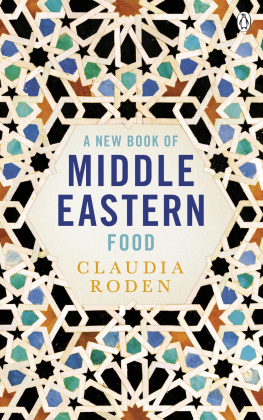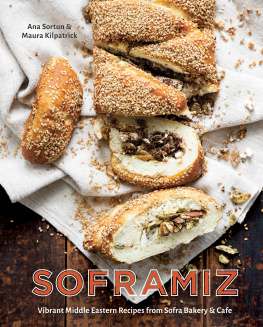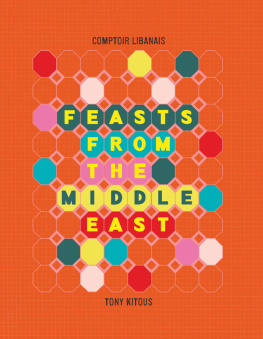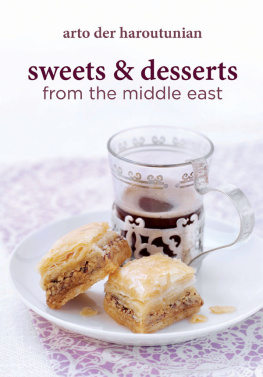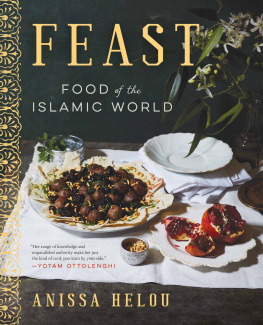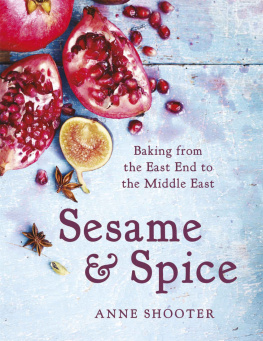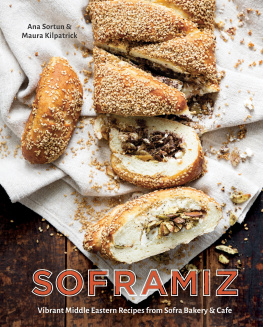
For my friend Ilaria and my brother Joseph, who have been instrumental in my successful transition from the art world to the food world.
Text copyright 2015 by Anissa Helou.
Photographs copyright 2015 by Chronicle Books LLC.
All rights reserved. No part of this book may be reproduced in any form without written permission from the publisher.
ISBN 978-1-4521-3062-0 (epub, mobi)
Library of Congress Cataloging-in-Publication Data available.
ISBN 978-1-4521-1439-2 (hc)
Designed by Alice Chau
Photographs by Linda Pugliese
Food styling by Chelsea Zimmer
Prop styling by Kira Corbin
The photographer wishes to thank her dedicated teamChelsea Zimmer, Kira Corbin, Julia Gartland, Leslie Gordon, and Sophie Lengfor all their hard work and support. She would also like to thank Alice Chau for her trust and collaboration.
Chronicle Books LLC
680 Second Street
San Francisco, California 94107
www.chroniclebooks.com
contents

introduction
I have a strong sweet tooth and I often say its because my family name, Helou, means sweet in Arabic. In truth, that has nothing to do with it. Most people in the Middle East and North Africa have a serious penchant for all things sugary. Sweets occupy an important place in our lives, and every important occasion, rite of passage, or religious event has a specific sweet associated with its celebration. In fact, any occasion is a good enough reason to visit the sweets maker, whether to enjoy a snack while going about your daily business or to buy a treat to take to friends or family.
Its possible that this love of sweet things is a result of the Muslim prohibition against alcohol, with sugar from sweets replacing the sugar derived from alcohol. Perhaps sugar (from the Arabic word sukkar, derived from the Persian shakar) was so plentiful in the Middle East that a tradition of candy and pastry making was established. Sugarcane was originally grown in the tropical Far East; from there it was taken to India and China and on to Persia in the fifth century. After the Arabs invaded Persia in the seventh century they carried sugar with them to Egypt, North Africa, Sicily, Spain, and other places they conquered. When the Crusaders left the Middle East, they brought sugar with them back to Europe. Sugar was not the only sweetener available in the Middle East (honey and molasses from grapes, dates, and carob were and still are used as well), though it was plentiful there long before sugar became common in the West.
The sugar industry started in Egypt in the eighth century, and the Egyptians were considered pioneers in refining sugar. Theyre still major growers and producers of sugar, with more than three hundred million acres given over to growing sugarcane, which does not include the land on which sugar beets are grown. Iran is another country with an important sugarcane growing and refining industry.
Sweets are an essential part of the legendary Middle Eastern and North African hospitality, and they are ever-present in peoples homes, stored in beautiful glass or metal boxes and placed on coffee tables in living rooms so hosts can offer them to guests with coffee, tea, or a refreshing drink. Everyone brings a gift when invited to someones home, and sweets are often what visitors bring with them.
Wherever you go in the region, whether in the souks, bazaars, or the modern parts of cities, you find confections of all kinds. Some are piled high on carts by the roadside, others delicately arranged on huge metal trays in the shops of sweets makers. Dont assume that sweets sold on the street arent as good as those displayed in elegant stores. Some may be of lesser quality, but others will have been lovingly prepared by the vendors in their homes and match those available at the finest shops.
Most people in the Levant still cook elaborate meals at home, though few home cooks prepare their own desserts, even if they know how. In North Africa, home cooks are very proud of their pastry-making skills. Apart from a few and various puddings that are considered the preserve of the home cook, most Levantines buy their desserts and pastries from specialty shopsjust as many French and Italians do. In the Middle East and North Africa, however, these delicacies are enjoyed not so much for dessert at the end of the meal, when fruit is usually served, but rather for breakfast or between meals with coffee or tea.
As a child in Beirut, I often went with my mother or sometimes my father to buy sweets, simply as a treat for us to have at home or to take to my grandmother who lived in East Beirut, the Christian part of the city. We lived in West Beirut, the Muslim part, and it was there that all the great confectioners had their stores. They were mainly Muslim, with many having been in the business for generations. In the 1960s when I was growing up there, the most famous were the Samadis and the Bohsalis in Beirut and the Hallabs in Tripoli (the last two are still going strong, though Samadi Sweet Shop may have lost its shine). I speculate that most confectioners are Muslims because Christians had to be austere during the forty days of Lent. Muslims, on the other hand, enjoyed a feast every night during Ramadan (the Muslim month of fasting), with sweets taking center stage throughout that month as well as for the feast celebrating the end of Ramadan, Eid al-Fitr (known as eker Bayram, Sugar Feast, in Turkey), and the even bigger feast a month or so later, Eid al-Adha. Christians celebrate with sweets as well, especially at Easter, but not so extravagantly.
What I never noticed when I lived in Beirut was the lack of access to the confectioners kitchens. It was never a problem peeking into restaurant kitchens or watching bakers at work, but it wasnt until I started writing about food that I realized I had never been inside any sweets-makers kitchens. That mysterious world was out-of-bounds to everyone except professionals. The very first time I visited Gllolus baklava kitchens in Istanbul, it felt like walking into an enchanted world: everything was cloaked in clouds of white dust (created by the cornstarch, which is used to keep the phyllo from sticking as it is rolled out). Men in white moved gracefully and dexterously, rolling out incredibly large, diaphanous sheets of phyllo dough, which they then flapped one by one before laying them on large metal trays, building layers interspersed with chopped nuts to make different types of baklava.
Later, I was fortunate enough to be allowed inside the kitchens of Pistache dAlep in Aleppo, and there I finally discovered the art of making cotton candy (ghazl al-banat in Arabic), an extraordinary confection made by stretching caramel and coating it with toasted flour. As the caramel is stretched again and again, it separates into millions of incredibly fine strands that are then coiled into balls that melt on your tongue as you eat them, as if you were eating sweet air. Later still, I visited the kitchens of mam ada in Gaziantep in southeastern Turkey, where the atmosphere was positively medieval. The wood fire in the oven cast a warm orange glow over the men, who made the baklava dance by pouring hot syrup over it. The syrup made the top layers of phyllo bob up and down, though never strongly enough to fly off the tray.
The repertoire of sweets is vast, from puddings to syrupy pastries to cookies to ice creams to candied fruit, nuts, and even some vegetables such as eggplant. From these I have chosen an exciting selection of recipes that can be made by amateur home cooks. The satisfaction of making a perfect
Next page


